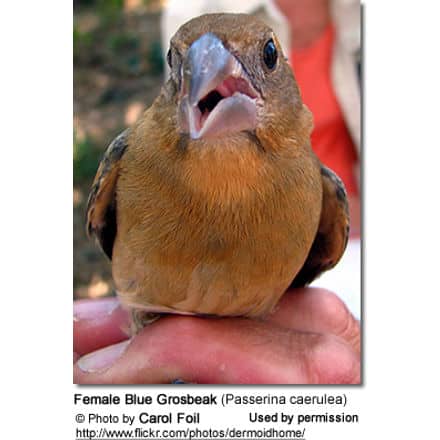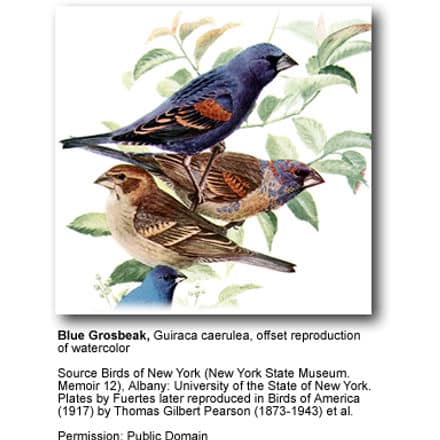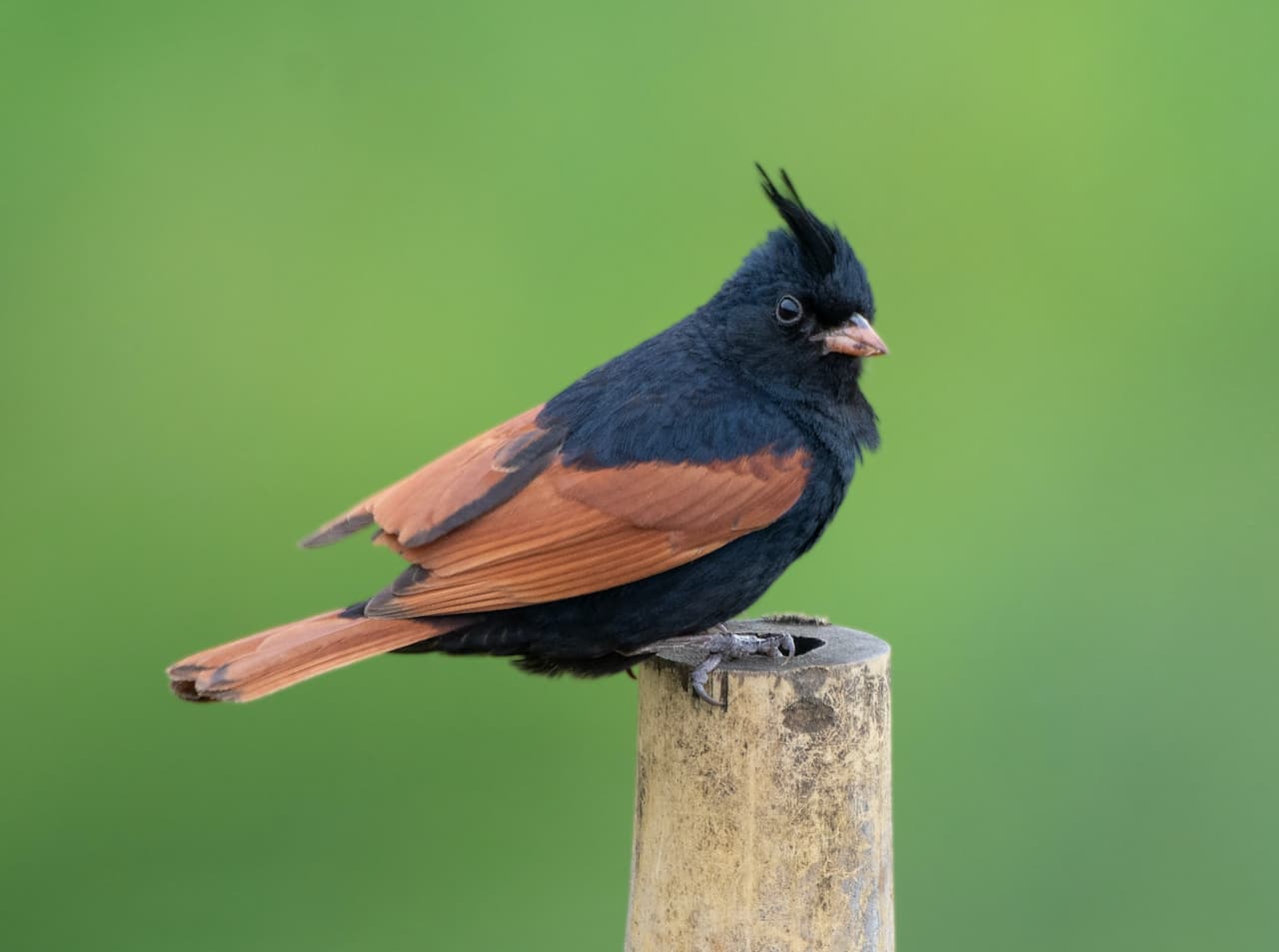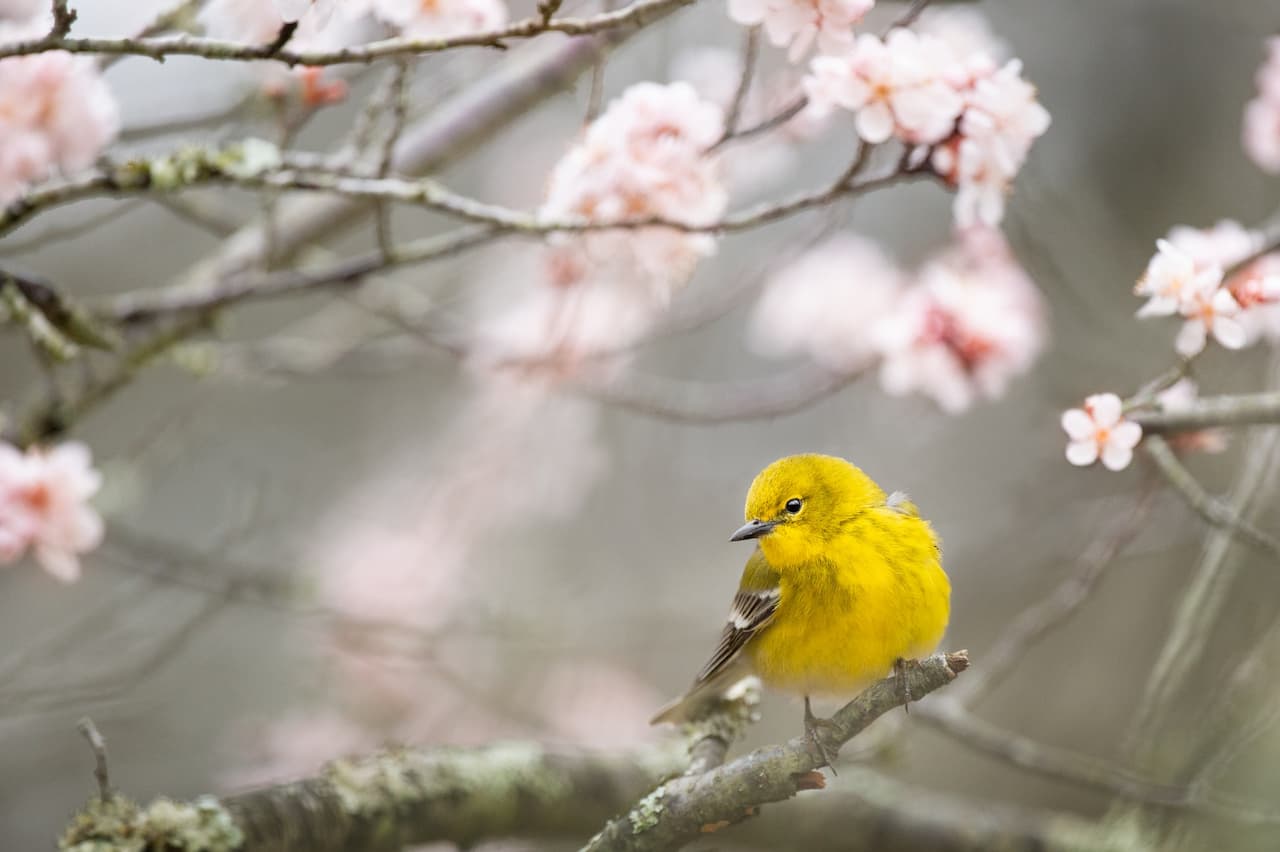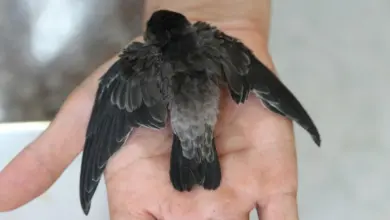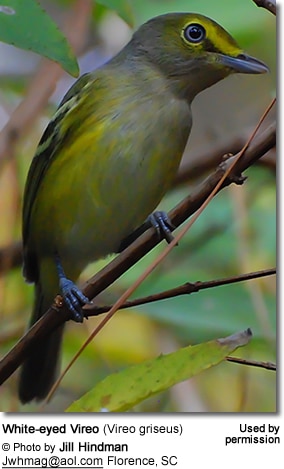Blue Grosbeaks
The Blue Grosbeaks (Passerina caerulea) are medium-sized, colorful songbirds with an extremely large range across much of North and Central America.
They were named for the blue plumage of the male, and their large beaks (derived from the French word “gros-bec,” translated “big beak”).
These seed-eating birds are in the same bird family as the Northern Cardinal, and genetic evidence suggests that the Lazuli Buntings are their closest relatives.
Distribution / Habitat
The Blue Grosbeaks breed across most of the United States – with populations occurring in central California, east through Nevada, Colorado, the Dakotas, Kansas, Missouri, Illinois and New Jersey south to central Florida and the Gulf of Mexico coast, through Mexico and Central America as far south as Panama.

They migrate south to winter in Mexico, Central America (south to Costa Rica), and the Caribbean. Occasionally, they winter in southern USA.
Vagrants occur as far north as New Hampshire, USA and as far south as northern South America (the southernmost record being from eastern Ecuador). Isolated records of them exist in Norway (2 males – reported in 6/1970 and 11/1987), Sweden (1980, 1983) and Britain (1970, 1972, 1986). These may have been escaped captive birds.
They are usually found along forest edges, in open areas with scattered trees, overgrown fields, brushy pastures and in riparian areas, along farm hedgerows and ditches, and other areas with medium-sized trees and low shrub density
Subspecies and Ranges:
- Blue Grosbeaks(Passerina caerulea caerulea – Linnaeus, 1758)
- Breed in eastern USA from Kansas, Kentucky, southeastern Pennsylvania and southern New Jersey south to central and southern Texas, southern Louisiana, central Alabama and central Florida.Winter from eastern and southern Mexico south to Panama.
- California Blue Grosbeaks(Passerina caerulea salicaria – Grinnell, 1911)
- Breed in southwestern USA, in central and southern California, west central Nevada and southwestern Arizona) and extreme northwestern Mexico in northwestern Baja California.Winter in southern Baja California and western Mexico, from southern Sonora south to Guerrero and Morelos.
- Western Blue Grosbeaks(Passerina caerulea interfusa – Dwight and Griscom, 1927)
- Breed in western USA, in southern South Dakota south to Arizona and New Mexico; and northern Mexico, in central Sinaloa, Durango and northern Coahuila).Winter in western Mexico, in the states of Sonora and Durango, south to the country of Honduras.
- Western Blue Grosbeaks(Passerina caerulea eurhyncha – Coues, 1874)
- Range: Central and southern Mexico from southern Tamaulipas south to Oaxaca.
- Western Blue Grosbeaks(Passerina caerulea lazula – Lesson, 1842)
- Range: Southern Guatemala, El Salvador and Honduras south through Pacific drainage to northwestern Costa Rica.
- Passerina caerulea deltarhyncha (van Rossem, 1938)
- Range: Along the Pacific slope in Mexico from southern Sonora south to Guerrero.
- Passerina caerulea chiapensis (Nelson, 1898)
- Range: Southern Mexico (eastern Oaxaca and Chiapas) east to southern Guatemala.
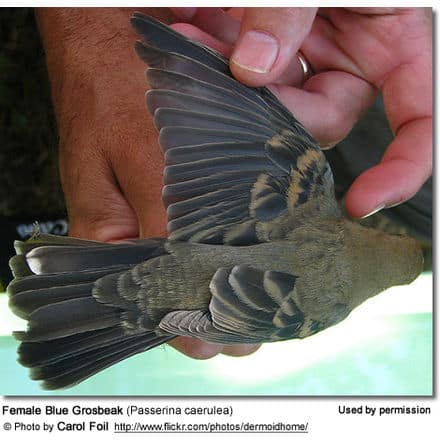
Description
Blue Grosbeaks measure 5.51 – 6.69 inches (14 – 17 cm) in length, including the tail, and have a wingspan of about 10 – 11 inches (26 – 29 cm). They weigh between 0.92 – 1.11 oz (26 – 31.5 g).
Males and females can easily be identified by the different color of their plumages.
The breeding male Blue Grosbeak is has a nearly entirely deep blue plumage with a blackish face. Outside the breeding season, the blue feathers have brownish edges.
The female is mostly brown (paler below) with some pale blue markings on the rump and tail
Both have blackish wings and tails; large, cone-shaped, silver-grey bills; and reddish-brown wing bars.
They are often observed flicking and spreading their tails.
Immature Description
Juvenile females resembles adult females except they have less extensive blue markings on the rump.
Juvenile males look like an intermediate between adult females and adult males, with variable amounts of blue mixed with brown.
Similar Species
- Juvenile Lazuli Buntings are similar, but are smaller in size, have a paler plumage and smaller bills.
- Female and juvenile Brown-headed Cowbirds don’t have wingbars and may be streaked on the chest.
- The Eastern Bluebirds can be identified by their white bellies and reddish chests.
- Indigo Buntings are similar, but smaller in size, have smaller bills and the wingbars are either absent or less distinct.

Diet / Feeding
Blue Grosbeaks feed on insects – such as grasshoppers, cicadas and mantis; other invertebrates, such as snails; seeds of wild and cultivated grasses; grains; and wild fruits. They forage on the ground, or in shrubs and trees. During the migration, small flocks of them will often feed in rice, corn, and other grain fields.
Breeding / Nesting
Breeding usually occurs from March to July. The males usually reach the breeding territory first and sing to attract potential mates. In the northern parts of the range, they usually only raise one brood a year, and further south two (usually with the same mate).
It is believed that the female alone constructs the compact cup nest out of twigs, bark, rootlets, and other fibers and strips of material found in her environment, including snakeskin, rags, string, cellophane, or strips of newspaper. The nest is usually situated low in small trees, bushes, shrubs, or tangles of vines, briers, and other vegetation about 3.3 – 9.8 feet (1 – 3 meters) above the ground.
The average clutch consists of 3 – 5 pale blue, unmarked eggs that are incubated by the female alone for 11 – 12 days. The hatchlings are helpless and are mostly cared for by the female, including being fed by her. However, once they fledge, the male will also feed them, while the female may get started on a second nest.
The young leave the nest when they are about 9 – 12 days old.
Blue Grosbeaks are heavily parasitized by the Brown-headed Cowbird and the Bronzed Cowbirds, who will lay their eggs into the grosbeaks’ nest for them to incubate and raise as their own. Blue grosbeaks have also been reported to build their nest on top of a parasitized nest and have successfully raised both cowbird chicks and their own young.
Calls / Vocalizations / Sounds
Alternate (Global) Names
Chinese: ????? … Czech: dlaskovec modrý, Papežík modrý … Danish: Blå Kernebider, Koboltkernebider … Dutch: Blauwe Bisschop … Finnish: Sinikardinaali … French: Cardinal bleu, Gros-bec bleu, Guiraca bleu, Passerin bleu … German: Azurbischof, Azur-Bischof, Azurfink … Haitian Creole French: Giraka ble … Icelandic: Niðtittlingur … Italian: Beccogrosso azzurro, Beccogrosso blu … Japanese: ruriikaru … Lithuanian: M?lynasis kardinolas … Norwegian: Blåtykknebb … Polish: luszcz blekitny, ?uszcz b??kitny, luszczyk blekitny, ?uszczyk b??kitny … Russian: ??????? ???????, ????? ??????????, ????? ?????????? … Slovak: pápežík modrý … Slovenian: modri kardinal … Spanish: Azulejo, Azulejo Real, Azulejón, Azulillo Grande, Azulón Norteño, Cardenal Azul, Picogordo Azul, Picogrueso Azul, Piquigrueso Azul … Swedish: Blåtjocknäbb, Gulhuvad trupial … Turkish: mavi kocaba?



